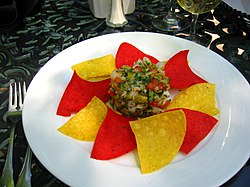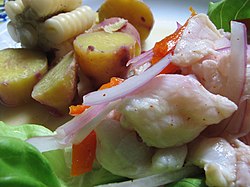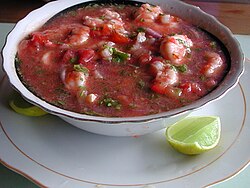Ceviche
From Wikipedia, the free encyclopedia
| This article does not cite any references or sources. Please help improve this article by adding citations to reliable sources (ideally, using inline citations). Unsourced material may be challenged and removed. (March 2009) |


Ceviche (also spelled as cebiche or seviche) is a form of citrus-marinated seafood appetizer, popular in mainly Latin American countries like Peru, Panama, Ecuador, Mexico, Guatemala, Colombia, and Chile. Both finfish and shellfish are used; finfish is typically raw while shellfish is typically cooked.
[edit] Origin
One hypothesis suggests that ceviche got its name from the Quechua word "siwichi." However, another hypothesis suggests that the name is a cognate of the Spanish word "escabeche" (marinade), derived from the Arabic term "sikbaj." Another hypothesis suggests that its name comes from the word Cebo, the name given to the corvina fish.
Ceviche is marinated in a citrus-based mixture, with lemons and limes being the most commonly used. In addition to adding flavor, the citric acid causes the proteins in the seafood to become denatured, which pickles or "cooks" the fish without heat. Traditional style ceviche was marinated up to 3 hours. Modern style ceviche usually has a very short marinating period. With the appropriate fish, it can marinate in the time it takes to mix the ingredients, serve, and carry the ceviche to the table.
Every Latin American country has given ceviche its own touch of individuality by adding its own particular garnishes. In Panama, ceviche is served with little pastry shells called "canastitas." In Peru, it is served with slices of cold sweet potatoes or corn-on-the-cob. In Ecuador, it is accompanied by popcorn, nuts, or corn nuts. It is also served in a large crystal bowl with the guests helping themselves by spearing it with toothpicks.
It is an original and typical dish of the fishermen of the American coast. Peru is often noted as the birthplace of ceviche as the various Peruvian civilizations that arose in the Pre-Columbian period greatly depended on fishing. Later, several important South American ports arose in Peru as a result of the Spanish Viceroyalty's capital being located at Lima (in Peru's central coast). Nonetheless, the originality of the birthplace of the popular dish is often disputed by other countries such as Ecuador, Panama and Mexico; all of which also have their own unique varieties.
[edit] Variations
In Panama, ceviche is prepared with lime and lemon juice, chopped onion and celery, habanero pepper, and sea salt. Ceviche de corvina (white sea bass) is very popular and served as an appetizer in most local restaurants. It is also commonly prepared with octopus, shrimp, and squid. Panama is currently exporting ceviche to the United States.
In Peru, it is composed of chunks of raw fish, with lime or lemon juice though sometimes bitter orange (naranja agria), sliced onion, minced Peruvian ají limo, or the popular Andean chilli rocoto are included. The mixture is marinated and served at room temperature, often with cancha (toasted kernels of maize), usually referred to as canchita, chunks of corn-on-the-cob, slices of cooked sweet potato and/or white potato, and yuyo (seaweed). There are many regional variations. A specialty of the traditional central coast (i.e., Lima, Trujillo) is ceviche prepared from shark (tollo or toyo). Corvina (sea bass) or lenguado (sole) is also used. Many Peruvian cevicherías serve a small glass of leche de tigre or leche de pantera as an appetizer, which is a small quantity of the lime juice marinade. In its classical version, ceviche is a very simple dish: fresh sliced fish (white meat fish is better), freshly squeezed key lime juice, sliced onions, salt and chile (ají limo or rocoto).
In Ecuador, especially in the Quiteño tradition, shrimp ceviche tends to be made with ketchup or tomato sauce. The Manabí style, made with lime juice, salt and the juice provided by the shrimp itself is very popular. Occasionally one can find ceviche made with clam. It is served in a bowl with toasted corn kernels as a side dish (plantains and pop corn are also typical ceviche side dishes). Sea bass, octopus and crab ceviches are also common in Ecuador. A spondylus ceviche, a delicate clam only found in certain parts of the Manabí province, is a rare treat. The Incas referred to the spondylus as the food from the gods.
In Chile, ceviche is often made with fillets of halibut or Chilean sea bass, and marinated in lime and grapefruit juices, as well as finely minced garlic and red chile peppers. Often fresh mint and cilantro are added.
In Mexico and other parts of Central America, it is served in cocktail cups with crackers, or as a tostada topping and taco filling. Shrimp, octopus, squid, tuna, and mackerel are popular bases for Mexican ceviche. The marinade ingredients include salt, lemon, onion, chile, avocado, coriander, and parsley. Tomatoes are often added to the preparation.
In Cuba, ceviche is often made using mahi-mahi prepared with lime juice, salt, onion, green pepper, habanero pepper, and a touch of allspice. Squid and tuna are also popular.
In Costa Rica, the dish includes marinated fish, lime juice, salt, ground black pepper, finely minced onions, cilantro and finely minced peppers. It is usually served in a cocktail glass with a lettuce leaf and soda crackers on the side as in Mexico. Popular condiments are tomato ketchup and tabasco. The fish is typically tilapia or corvina although mahi-mahi, shark and marlin are popular.
[edit] See also
| Wikibooks Cookbook has a recipe/module on |
| Wikibooks Cookbook has a recipe/module on |
| Wikimedia Commons has media related to: Ceviche |





